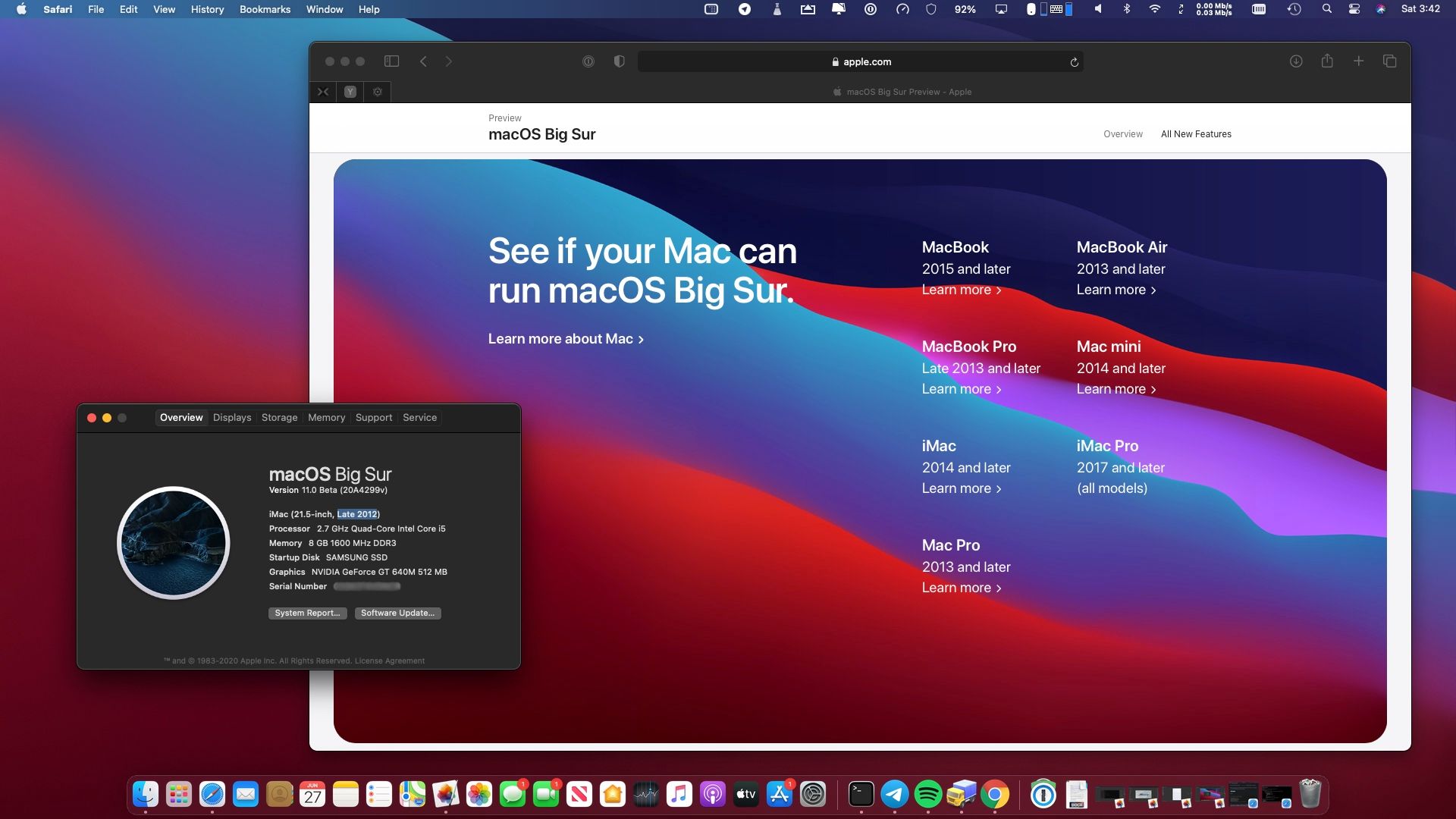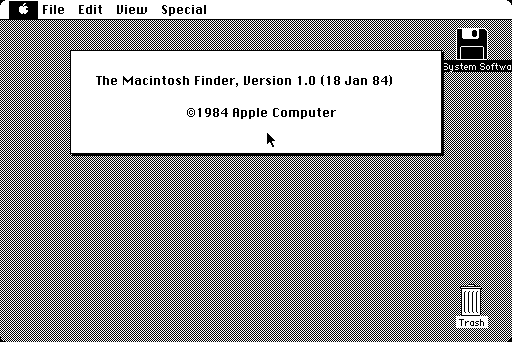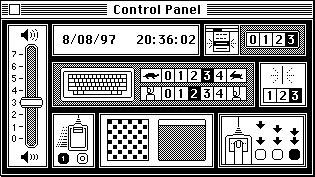| A version of the classic Mac OS operating system | |
| Developer | Apple Computer, Inc. |
|---|---|
| OS family | Macintosh |
| Source model | Closed source |
| Released to manufacturing | January 24, 1984; 37 years ago |
| Latest release | 1.1 / December 29, 1984; 36 years ago |
| Kernel type | Monolithic |
| License | Proprietary |
| Succeeded by | System 2 |
| Support status | |
| Archaic, unsupported | |

The Macintosh 'System 1' is the first version of AppleMacintosh operating system and the beginning of the classic Mac OS series. It was developed for the Motorola 68000microprocessor. System 1 was released on January 24, 1984, along with the Macintosh 128K, the first in the Macintosh family of personal computers. It received one update, 'System 1.1' on December 29, 1984, before being succeeded by System 2.[1]
With the exception of Mac OS X Server 1.0 and the original public beta, OS X versions were named after big cats until OS X 10.9 Mavericks, when Apple switched to using California locations. Prior to its release, Mac OS X 10.0 was code named 'Cheetah' internally at Apple, and Mac OS X 10.1 was code named internally as. MacOS 8.1 screen shots. These screen shots are of a default install of MacOS 8.1 running under Basilisk II. This is the highest version of MacOS that Basilisk II can run. Mac OS 8.1 Booting up. The MacOS 8.1 about screen. One of the more obvious improvements introduced in MacOS 8 is the 3-d window appearance. Tested on production 1.4GHz quad-core Intel Core i5-based 13-inch MacBook Pro systems with 8GB RAM, 256GB SSD, and prerelease macOS Big Sur. Tested with prerelease Safari 14.0.1 and Chrome v85.0.4183.121. Performance will vary based on usage, system configuration, network connection, and other factors. PCE.js Mac Plus emulator running Mac OS System 7 — a hack by James Friend PCE.js emulates classic computers in the browser. This is a simulation of a Classic Macintosh from 1984, running System 7.0.1 with MacPaint, MacDraw, and Kid Pix.
Features[edit]
This operating system introduced many features that would appear for years to come, some that still exist in the current macOS, and a few that exist in other graphical operating systems such as Microsoft Windows.
The features of the operating system included the Finder and menu bar. In addition to this, it popularized the graphical user interface and desktop metaphor, which was used under license from Xerox PARC.
Due to the limited amount of random-access memory and the lack of an internal hard disk in the original Macintosh, there was no multitasking with multiple applications, although there were desktop accessories that could run while another application was loaded. Also, items in the Trash were permanently deleted when the computer was shut down or an application was loaded (quitting the Finder).
System 1's total size is about 216 KB and contained six files: System (which includes the desk accessories), Finder, Clipboard, an Imagewriter printer driver, Scrapbook, and Note Pad.[2] A separate diskette included 'A Guided Tour of Macintosh', which contains tutorial demonstrations of the Macintosh system, running on a modified pre-release version of Finder 1.0, as well as training programs for learning to use the mouse, and the Finder. Also included was a 33-minute audio cassette designed to run alongside the demonstrations, emphasising the disk's purpose as a guided tour.[3]
Menu bar[edit]

The menu bar was a new and revolutionary part of the OS.[citation needed] Similar to the one found on Lisa OS, the System 1 Finder had five menus: the Apple menu, File, Edit, View, and Special. When in an application, the menus would change to ones defined by the application, but most software retained at least the File and Edit menus.[4]
While within the Finder, the Apple menu contained the 'About the Finder' information, along with the desktop accessories. 'File' menu items included Open, Eject, and Close. 'Edit' had entries for cutting, copying, and pasting. 'Special' was used for managing the hardware and other system functions, and was always the rightmost entry on the menu bar in the Finder. In System 1, the menu had items related to emptying the Trash, cleaning up the desktop, and disk options. By System 1.1, the menu allowed the user to choose an alternate startup program to be run instead of the Finder at boot time; the feature was replaced in System 7 by the 'Startup Items' folder in the System Folder.[citation needed]
Desk accessories[edit]
System 1 came with multiple desk accessories (DA). These included an Alarm Clock, Calculator, Control Panel, Key Caps, Note Pad, Puzzle, and Scrapbook. A difference between desktop accessories and applications is that multiple desktop accessories could be run at once but only one application could run at a time. Desk accessories could also run on top of an application.
- Alarm Clock — This DA could be used just like an alarm clock, as the computer would beep, and the menu bar would flash when the alarm's set time was reached. It could also be used as an easier way to change/set the time and date on the computer. When opened, it would show the time and date set on the computer.
- Calculator — A basic calculator capable of addition, subtraction, multiplication, and division. It featured the basic 18 buttons for input.
- Control Panel — The control panel was used to adjust some of the settings on the computer. What made the original control panel unique from subsequent Mac OS control panels was the intended absence of any text. This was chosen to demonstrate the graphical user interface. Representation was achieved by using symbols. It could be used to adjust settings such as volume, double click speed, mouse sensitivity, and desktop background. On the Macintosh 128K, Macintosh 512K, and the Macintosh Plus, the screen brightness was controlled by a mechanical adjustment wheel beneath the screen.
- Key Caps — A DA used to show the layout of the original Macintosh keyboard. It showed what happened when normal keys were pressed along with special characters (Command, Shift, Option).
- Note Pad — A note taking DA that would save text entered into it on the floppy disk. Multiple note pages could be written when using the folded corner symbol in the bottom left corner of the note page.
- Puzzle — A basic 1-15 slide puzzle, similar to the picture puzzle found in later versions of the Mac OS.
- Scrapbook — This DA was similar to a cut, copy, and paste library. In it, one could store text selections and photos which could then be transferred to other applications.
See also[edit]

References[edit]
- ^Mesa, Andy. 'The Early Mac OS'. The Apple Museum. Retrieved 2015-02-15.
- ^Pogue, David (January 1997). MacWorld Macintosh Secrets 4th Edition - Part 1: System Software Revealed(PDF). Hungry Minds. p. 216.
- ^'First Versions: Apple Mac OS'. First Versions. Retrieved 14 January 2018.
- ^Conachey, Andrew. 'Innovative Macintosh System 1'. Low End Mac. Retrieved 2016-08-15.
External links[edit]
- Macintosh System 1 in your browser – A web-based simulator
- System 1.0 Headquarters — a walkthrough of System 1 with screenshots (from 1998, via archive.org)
| Preceded by | System 1 1984 | Succeeded by System 2 |
Increased security
High Sierra is an update of MacOS which focuses mostly on back-end developments and a higher level of user security. As such, this operating system lays a foundation for future upgrades.
Stay safe
In essence, High Sierra took what was good with Sierra and developed it into a more comprehensive software.
High Sierra emphasizes the already-existing benefits of MacOS previous system, Sierra. There are few bells and whistles, but the changes are noticeable and positive. The Apple file system is the most significant feature it brought. It enables the storage and encryption of a large number of files. Thus, it boosts performance and helps manage device memory issues.
Apple also introduced new formats for video and photos in this version. These formats compress data - that’s a benefit as files can get huge with ever-rising resolutions. They added support for virtual reality headsets as well.
Besides that, when it comes to Safari, Mac search engine, there are some notable improvements with the update. The users can now control annoying auto-play videos, prevent tracking, and more. There are also notification controls, and you will experience a boost in performance, too.
The most noticeable changes took place in Apple’s Photo App, though. It went through a total revamp both visually in its interface and terms of tools and functions available. Many other discreet changes happened all over the system.
Where can you run this program?
If you’re running Sierra on your Mac, you will be able to run this one as well.
Is there a better alternative?
Yes. Mojave, the newest version of MacOS, brought even more improved features to the table. However, if you can’t run it on your device, this is the second best.
Our take
High Sierra is not the shiniest upgrade Apple brought, but it’s one that sets the stage for new upgrades to come. Even out of that context, it’s a great operating system.
Apple Mac OS X 10.1 ('Puma' 10.1.5F24)
Should you download it?
Yes, if your device can support it. The new options and better security settings are worth getting.
Highs
Videos For Mac Os 1
- Improved storage
- Smaller image and video sizes
- Handy Safari updates
- Upgraded security
Lows
MacOS - Wikipedia
- Apps require updates for compatibility
- Siri produces questionable results
Macintosh
macOS High Sierrafor Mac
Mac Os 11
10.13




